Many gardeners are engaged in growing strawberries. Some of them plant Symphony variety. This plant is resistant to verticillous wilting and has good frost resistance.
Table of contents
Description of Strawberry Symphony
Strawberry Symphony was bred in 1979 in Scotland by crossing varieties of Holiday and Rhapsody.
It has long stems, the height of which can reach 40 cm. The branched root system of the plant goes underground 25-35 cm deep.
The basal leaves of strawberries are quite hard and large. Their lower part is covered with slightly protruding veins.
According to the description, the berries have a bright red skin, conical shape and juicy, evenly colored pulp. The fruits are fleshy, very sweet and juicy.
Symphony attributed to dessert varietiestherefore it is better to try fresh berries.
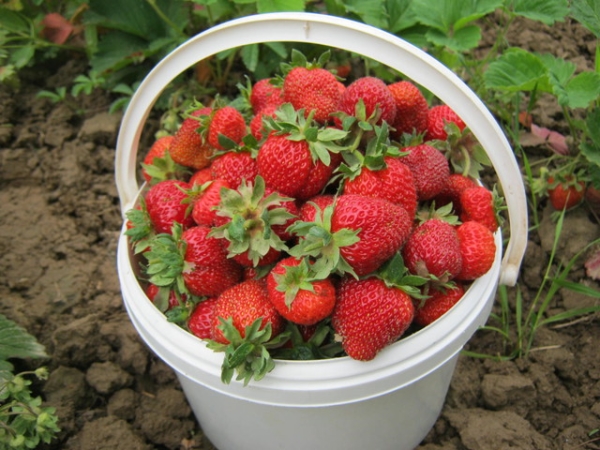
This variety can be planted not only in the southern edges. It winters well in Siberia, the Urals and the middle belt.
In the southern regions, the fruits begin to ripen at the end of May, and in the middle zone - in June or July. She has a long gestation period.therefore, the harvest can be harvested within two months.
The symphony yields an average of 200-350 g of berries from one bush. In the first year of life, productivity may be several times less.
At one plantation strawberries can grow for five years, after which it will have to be planted again.
Advantages and disadvantages of the variety
The symphony has quite a few advantages., thanks to which it is popular among lovers of growing strawberries:
- high yield;
- large and juicy berries;
- adaptability to hot and cold weather;
- resistance to gray mold, verticillus, fungal diseases;
- Lezhki fruits suitable for transportation.
Main disadvantage This variety is what it gives a crop only once a year.
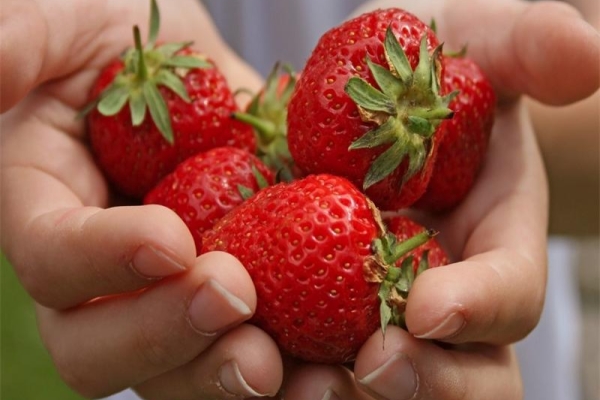
Landing
Before you start planting, you need to familiarize yourself with the features of this process.
When can I plant
Strawberries can be planted at the end of summer, in autumn or spring.. In autumn, it is planted until mid-September, so that next year you can harvest.
In spring, strawberries can be planted immediately after warming up the soil.. Many gardeners do this at the end of March or mid-April.

Site selection
For breeding strawberries should choose a sheltered from the wind and sunny area with black soil or forest soil.
Strawberries can not be planted in the ground, which contains a lot of clay.
Seedling
It should have a developed root system, thick and strong shoots, apical bud with three healthy leaves.
During the selection of seedlings need to carefully inspect its leaves. They should not be wrinkled or deformed. If there are any defects on them, then this indicates a lesion with a tick.
It is not recommended to buy young seedlings with a poorly developed root system., because even with good care for it, a full crop will appear only in a year.
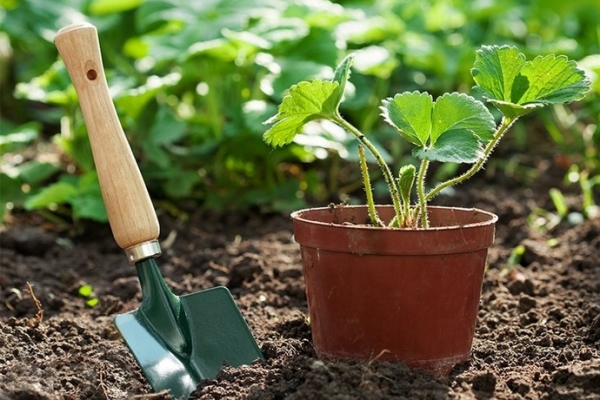
In the spring
Preparation of the site for planting should be engaged even before the onset of winter. Soil digging shovel in him 5-10 kg of manure, 100 g of potassium salt and 150 g of superphosphate are added.
It is not recommended to have the holes too close, as the strawberry grows heavily. The distance between them must be at least 35 cm.
Depth depends on the development of the roots. They should fit freely in the wells vertically.
To plant seedlings in two ways.: in dry or watered soil.
That the plant got acclimatized faster you can pinch it to the longest root or cut off the extra leaves.
To protect seedlings from sudden frost, it can be covered with plastic wrap.
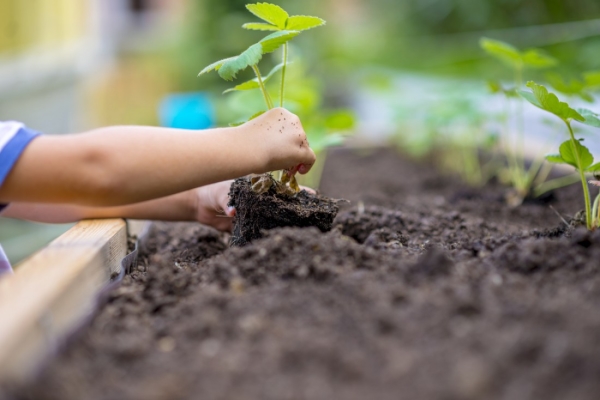
In the autumn
The main advantage of planting strawberries in the fall is that try harvest with young bushes will be next summer.
In the spring should be engaged in the preparation of the site. The soil is carefully digged and fertilized with humus. A week before planting, seedlings should be carefully examined.
Sprouts should not be disease or rot. After inspection, the roots should be treated with fungicides.
Planting seedlings in the ground is recommended in early September.. The wells are made deeper, so that in the winter they do not freeze. After placing the seedlings in the ground, the beds are watered.
Planting strawberries in the fall:
Cultivation and care
During the cultivation of strawberries, all efforts are directed at building up a strong root system. To do this, periodically fertilize the soil, water and trim the plant.
Watering
Because of an insufficient amount of water, the roots begin to dry out, and because of its excess, root or gray rot appears. therefore water the plant must be very careful.
A square meter plot is watered with 10 liters of water every two weeks. In the summer you need to water the plant 2-4 times a week. In this case, water should not fall on the inflorescences or leaves.
The best way to water until flowers appear sprinkling. During flowering is recommended to use drip method.

Top dressing
Soil fertilized in early spring after trimming leaves. Under each bush pour out a pint of nitroammofosk.For its preparation, one tablespoon of the drug is added to 10 liters of water.
Strawberry bushes need potassium during fruit formation.therefore, potassium nitrate, chicken droppings or ashes should be added to the soil.
In August The plant should be fertilized with a solution of urea diluted with water.
Pruning
Engaged in trimming the leaves and antennae should be after fruiting. This is done with thin shears or ordinary scissors. It is necessary to cut only the sheet plate in order not to touch the growth point.
Antennae are removed in mid-August.. If the plant will be left for landing, then you need to cut the very first mustache. That he will be the best planting material.
If the plant was planted out of antennae, then in the first year you should not do pruning.
Pruning strawberries after harvest:
Preparing for the winter
Strawberries should be prepared for winter in late autumn. To do this, you need to cover it with tree branches or a special covering material. When using branches bushes should be covered completely.
If covering material is used for insulationthen it should be placed on a special arc, so that it does not firmly come into contact with the soil.
To do this, you can use agrotex, spandbod or any other material with a density greater than 60g / m².
Mulching
The soil is mulched to improve its properties and protect the plant from weeds. Quite often used for this film.
The advantages of this method are the purity of the berries and the rapid ripening of fruits.. It is better to use the material in black, as it contributes to the heating of the soil.
You can also use wheat or oat straw. Before use, it must be wet and dry under the sun. Straw mulch is laid in a layer up to 7-10 centimeters.

Diseases and pests
There are several common diseases of strawberry:
Black rot
Quite often, this variety suffers from black rot. It is manifested by the blackening of young roots.. Over time, they become covered with dry constriction and become very fragile.
Because of this, the strawberry ceases to bear fruit and the buds do not form new lateral shoots. You can get rid of black rot with the help of Horus or Fitodoktora.
Mealy dew
The disease is manifested by white bloom on both sides of the leaves. They become very rough, twist inside and stop growing.
Most often, plants that are found in greenhouses suffer from powdery mildew.
When the first signs of illness appear, strawberry bushes should spray with Fundazol or Switch.
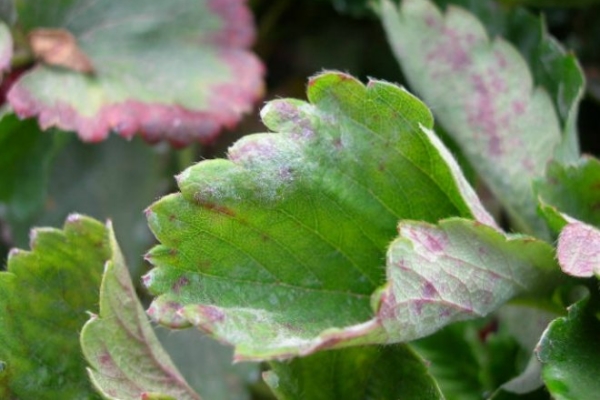
Withering
Quite often, the disease appears in the summer in hot weather. The source of infection is soil and weeds infected with fungi. During infection, leaflets, shoots and whiskers begin to change color.
If you do not treat the disease, the plant may die. To combat wilting fungicides should be added to irrigation water.
Pests
The main pests of strawberries include ticks, leaf beetles, nematodes and clickers. Also a plant can hit red ants, snails and slugs.
Prevention
Prophylactic treatment should be dealt with in spring and autumn after harvest. For this every spring is necessary take off the top layer of earthin which pathogens of diseases and larvae can be.
Strawberry Symphony can grow not only experienced gardenersbut also amateurs who have not done this before. To do this, it is enough to follow the recommendations for its cultivation and care.
